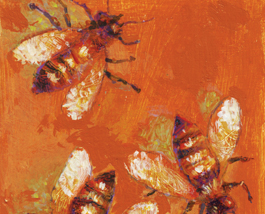home | north bay bohemian index | features | north bay | feature story

Detail of '5 Bees' by D. A. Bishop
Gone Buggy
Our second 'Biophilia' issue salutes bugs and, particularly, bees
By Gretchen Giles
The underlying theme of this week's special issue is listed on our editorial sheet as "The Earth: A User's Guide." That's got a certain panache to be sure, but really, every week is a so-called green week at the Bohemian. We're always striving to highlight ecological issues, concerns, solutions and the good people who work on them, whether in our News section, in Gianna De Persiis Vona's weekly "Green Zone" column, in the Eats area and even in Arts & Ideas.
Green, c'est . . . um, us.
Which set us to thinking. From this chair, it appears that the collapse of our fisheries and the collapse of our pollinators—particularly the colony collapse disorder haunting bees—are the two most under-reported ecological stories of the year. (Except, of course, in the Boho, where it's lately been nothing but an ocean of ink on fish and, curiously, a barrel of bytes on wine—but that's another matter.)
From the most vitriolic point of view, bees are used as mere slaves, trucked all over the United States to pollinate the vast almond orchards and other monocultures of Big Ag. Bee stories usually have a humorous tone and emphasize the many English-language puns afforded by their efforts (and, no, we're not immune). But the current story about bees is not at all funny. Experts estimate that almost 25 percent of all commercial bee operations suffered from CCD during the winter of 2006–2007. With a full third of all the food produced on earth relying on bees and other pollinators, this little-understood epidemic directly threatens human life. Honey, what's the buzz—indeed.
Estimated to have been on the earth for some 150 million years, bees are the only insect to produce anything eagerly eaten by humans. Their social structure is complex and perfect, their biology complex and perfect, their communication strategies complex and utterly, entirely perfect. Bees deserve to be hailed, and that's exactly what we've striven to do in this issue, devoting three stories to different apiarian aspects of the modern world.
We sent intrepid reporter Gabe Meline out with two professional bee-removal experts to don a veil and scoop thousands of insects out of the walls of the defunct Los Robles Lodge on a recent sunny afternoon. We sent intrepid intern Cassandra Landry up to the dreamy pleasures of the Melissa Garden to report on what can be done to create a safe haven and "spa" for bees in Healdsburg. And we sent intrepid freelancer Alastair Bland all over the place to determine whether urban bees are actually better off than the country-livin' ones (it appears that they are). A short list of farms that raise bees and sell their products is included in our calendar.
And once we started thinking about bees, things got more than a little buggy, prompting us to hail other insects in this issue, too. The light brown apple moth, which sounds like a Mother Goose protagonist but acts like one from the Brothers Grimm, may induce aerial spraying in Marin. Organic wines love their bugs, and it turns out that some insects are just so crunchy and yummy when they're cooked that snacking is in order.
Meanwhile, P. Joseph Potocki investigates whatever happened to the glassy-winged sharpshooter, and reports on the marvels of cheese made specifically to include the gastronomical wonders of live maggots. Finally, David Templeton gets the lowdown on the Top 10 most hated pests direct from the maw of a master gardener.
It's all in good fun, but it's all in good earnest. Bees may prompt a plethora of puns, but their current situation is deeply dire. To highlight this situation, there's even such a thing as National Pollinator Week, running Sunday–Saturday, June 22–28. To learn more, go to www.pollinator.org or to the North American Pollinator Protection Campaign at www.nappc.org.
Plant something that flowers. Reduce regular almond consumption. And please, don't kill that bee.
Send a letter to the editor about this story.
|
|
|
|
|
|